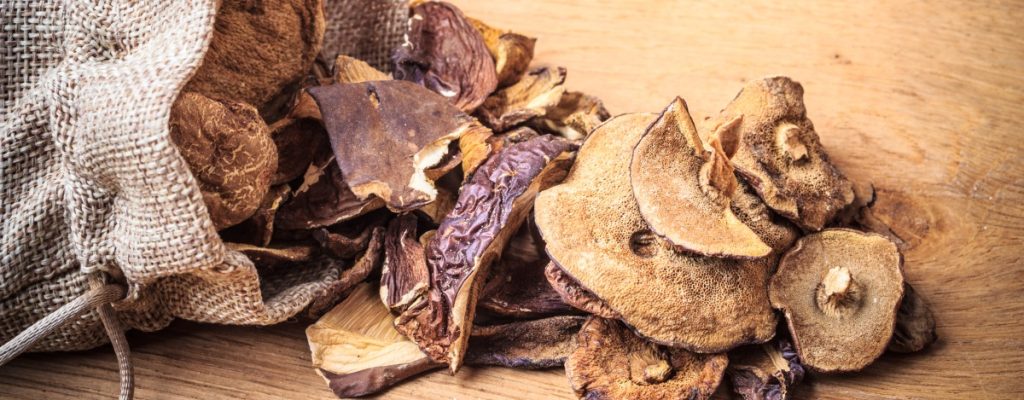Drying mushrooms is an excellent way to preserve delicious seasonal mushrooms so you can enjoy their benefits all year.
Having dried mushrooms or mushroom powder in your pantry is also convenient and allows you to easily add last-minute mushroomy goodness to your daily meals.
What’s more, drying mushrooms is easy. While some methods require expensive equipment and electricity, others are inexpensive and use the sun and wind for energy.
In this article, you’ll learn the benefits of drying mushrooms and how to dry mushrooms using four different methods with step-by-step instructions.
You’ll also learn how to store dried mushrooms, which mushrooms are best for drying and how to use dried mushrooms.
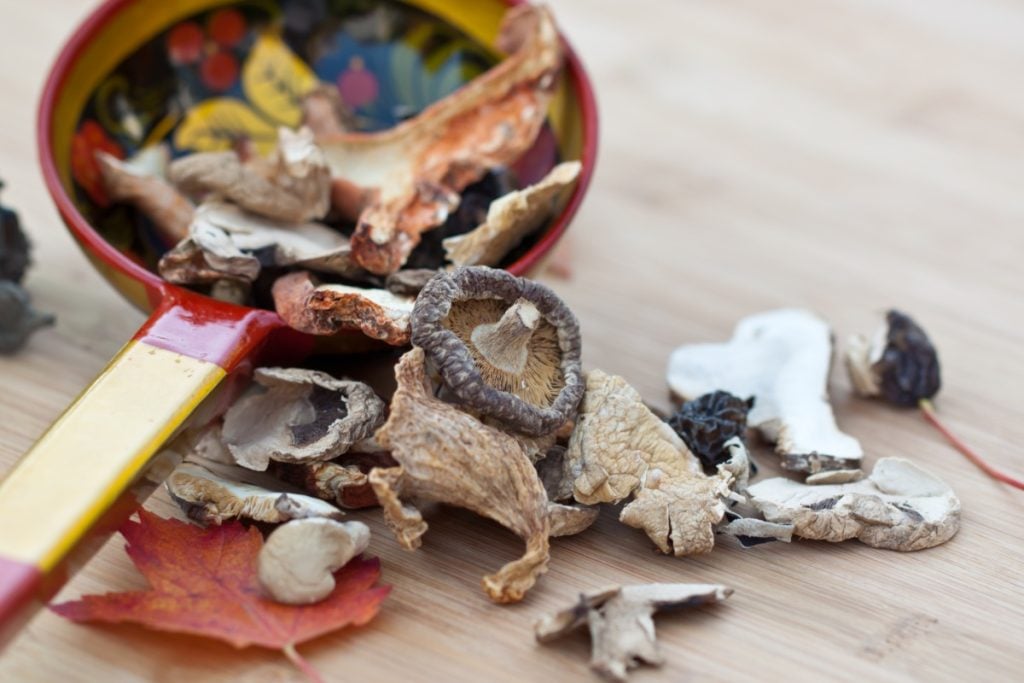
Why Dry or Dehydrate Mushrooms?
Drying is a great way to preserve surplus gourmet mushrooms before they go bad in the back of your fridge.
Drying or dehydrating mushrooms can also provide a year-round supply of delicious seasonal mushrooms.
Freezing and drying are the most popular methods for preserving mushrooms.
But, while you may have a small freezer with limited space, you can always find more space on a shelf or in a cellar to store dried mushrooms.
Another reason to dry mushrooms is that drying intensifies the mouth-watering umami flavor of some mushrooms.
Examples of these are porcini, morel, black trumpet, matsutake and, one of the most well-known: shiitake mushrooms.
Dried shiitake mushrooms are a staple ingredient in Asian cuisine, where they use their strong flavor to enhance broths, soups and stir-fries.
Drying mushrooms is also the first step in making mushroom powder which is perfect for those who do not enjoy the texture of fresh mushrooms.
You can add mushroom powder to numerous beverages and dishes, providing new ways to enjoy mushroom flavors and health benefits.
Drying is also a great way to utilize damaged mushrooms that you may not want to serve fresh.

Difference between Drying and Dehydrating Mushrooms
Drying and dehydrating processes both involve removing water from mushrooms; the difference is how you extract the water.
People usually use the term drying when the water removal process involves uncontrolled energy sources like sun and wind.
For example, washing drying on the line or wet paint drying as water or solvents evaporate.
But dehydration involves removing water using artificial heat and controlled temperature, humidity and airflow.
But, no matter whether you dry or dehydrate your mushrooms, you get dried mushrooms with enhanced flavor that are smaller and lighter, last longer and don’t need refrigeration.
How Do You Dehydrate Mushrooms?
The most common way to dehydrate mushrooms is using a dehydrator and the controlled airflow, heat and humidity is the key to success.
You can buy a dehydrator online, and they come in many shapes and sizes. Or, if you’re handy, you can make your own custom-built dehydrator.
The dehydrator lab has instructions on how to build a DIY food dehydrator, and homesteaders can learn how to make a solar-powered dehydrator.
Can You Dry Mushrooms in The Oven?
Yes, you can dry mushrooms in the oven, and for people without a dehydrator living in areas with high humidity, this is one of the best methods available.
4 Different Ways to Dry Mushrooms
Which method you use to dry mushrooms will depend on how many mushrooms you want to dry, your climate and what resources you have available.
The good news is that you can choose from a range of drying methods, including an equipment-free option.
Here are four different methods you can use to dry mushrooms:
1. Using a Dehydrator
Many people consider using a food dehydrator to be the best method of drying mushrooms.
The process is quick and easy, and you have greater control over temperature and airflow than with other methods.
It’s also easier to keep the mushrooms clean, and dehydrators usually don’t take up much space.
But, for those wondering, “how to dry mushrooms without a dehydrator?” The good news is there are three other drying methods that don’t need a dehydrator.
2. In the Oven
If you don’t have a food dehydrator, you can dry mushrooms in your oven.
The process takes a little longer, and you’ll need to stay nearby to check and turn the mushrooms until they have completely dried.
When drying mushrooms in the oven, you need to be careful that the temperature does not get too high.
3. Air-Dry Naturally
People have used wind and sun to air-dry foods naturally since ancient times, and this is an equipment-free method of drying mushrooms.
It takes longer to dry mushrooms naturally, and in areas with more than 60% humidity you’ll need to be careful as mold may begin to grow on your mushrooms.
4. Using a Freeze Dryer
Freeze-drying is an excellent way to preserve mushrooms long-term, but freeze dryers can be expensive.
Freeze-drying uses a vacuum instead of heat to extract the water from frozen mushrooms.
How to Dry Mushrooms With a Dehydrator
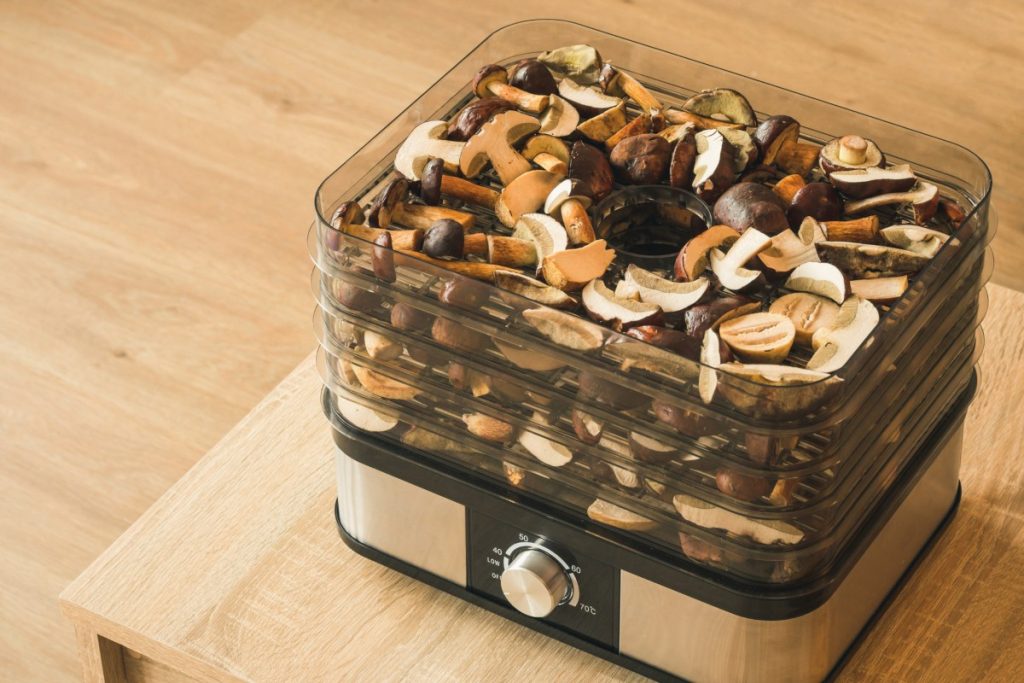
Follow the steps below to dry mushrooms with a dehydrator:
Step 1: Clean the Mushrooms
Mushrooms often have dirt, debris and insects on their stems or hiding between the gills.
When preparing mushrooms for drying, the first step is to trim and clean them.
Trim off any damaged or bruised sections and tough stems, then give your mushrooms a quick rinse under running water using a colander or sieve.
Don’t discard the mushroom stems as they’re edible and have numerous uses.
Once your mushrooms are clean, pat them dry with a paper towel or allow them to air dry on a kitchen towel before placing them in the dehydrator.
Some species of mushrooms are easier to clean than others, but for most, a rinse under running water is the best option.
Our article on how to clean mushrooms has more information and step-by-step guides for cleaning different types of mushrooms.
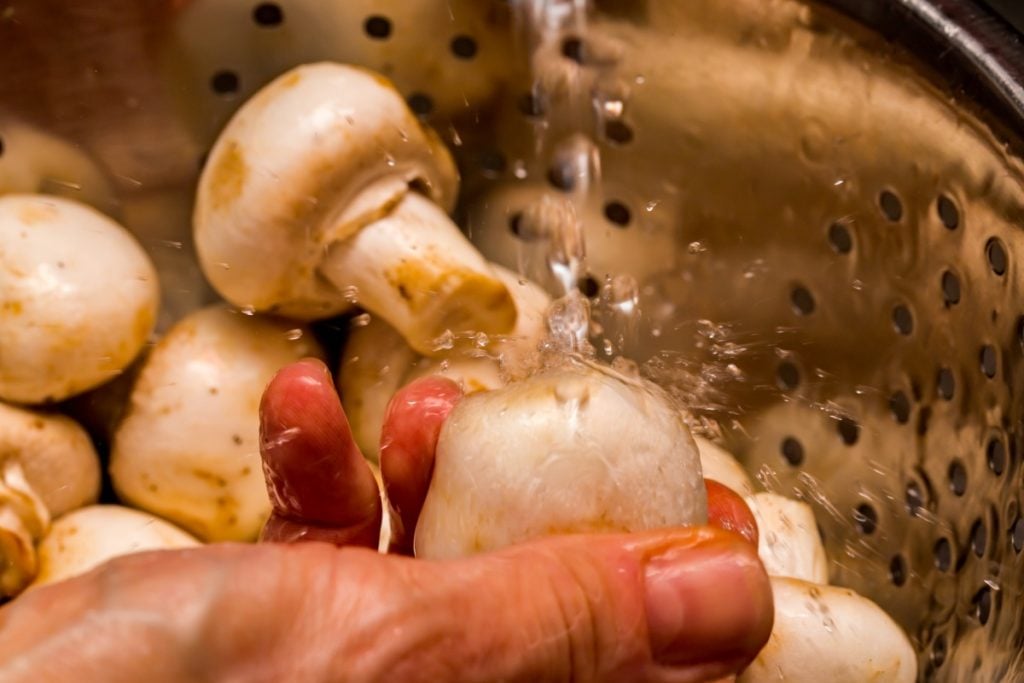
Step 2. Slice the Mushrooms
Depending on the type of mushroom, you can dry them whole or sliced, but it’s generally better to slice larger mushrooms.
Use a sharp knife to cut your clean mushrooms into slices 0.2 to 0.4 inches (0.5 to 1 cm) thick.
If you plan on making mushroom powder, you can dice them into smaller pieces making it easier to grind them into powder once they’re dry.
To properly dry in the dehydrator, the mushroom slices or pieces should be similar in size. If not, some will dry much faster than others.
The thicker the slices, the longer it will take the mushrooms to dry, so if you want to save on electricity, 0.2 inch (0.5 cm) slices are best.
Step 3. Arrange the Mushrooms on the Dehydrator Trays
Arrange the sliced or whole mushrooms on your dehydrator trays in a single layer with enough space between them for air circulation.
If your dehydrator tray has large holes, we recommend lining it with a mesh liner cut to the size of the tray.
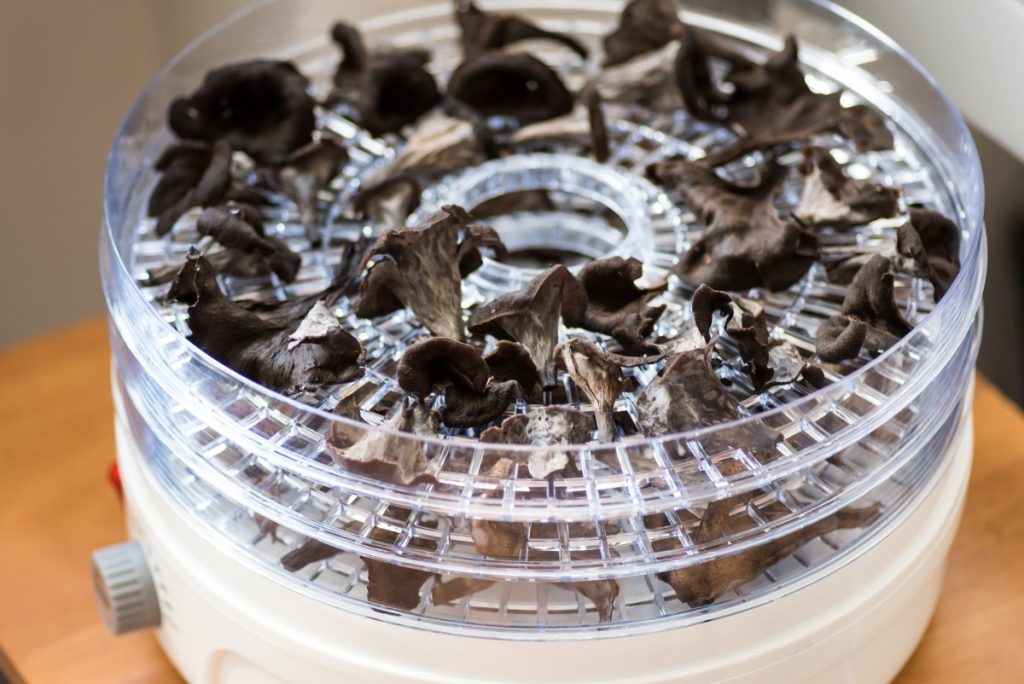
Step 4. Dehydrate the Mushrooms
Ensure there’s no excess water on your mushrooms before putting the trays into the dehydrator.
If necessary, pat them with a paper towel again to get them as dry as possible.
Dehydrate your mushrooms on a low setting between 110 and 135°F (43 and 57°C) until they are cracker-dry and brittle.
Depending on how thick your mushrooms are and how many are in the dehydrator, this can take anywhere from 4 to 12 hours.
But, generally, it takes around 6 to 8 hours to dry sliced mushrooms in a dehydrator.
How To Tell When your Mushrooms are Dry Enough
Dried mushrooms should be cracker-dry and brittle and break easily.
To test the mushrooms, let them cool, as they’ll get crisper while cooling, then break a few pieces.
If they break easily, they’re ready. But, if the mushrooms bend without snapping, they need to go back in the dehydrator.
How to Dry Mushrooms in The Oven
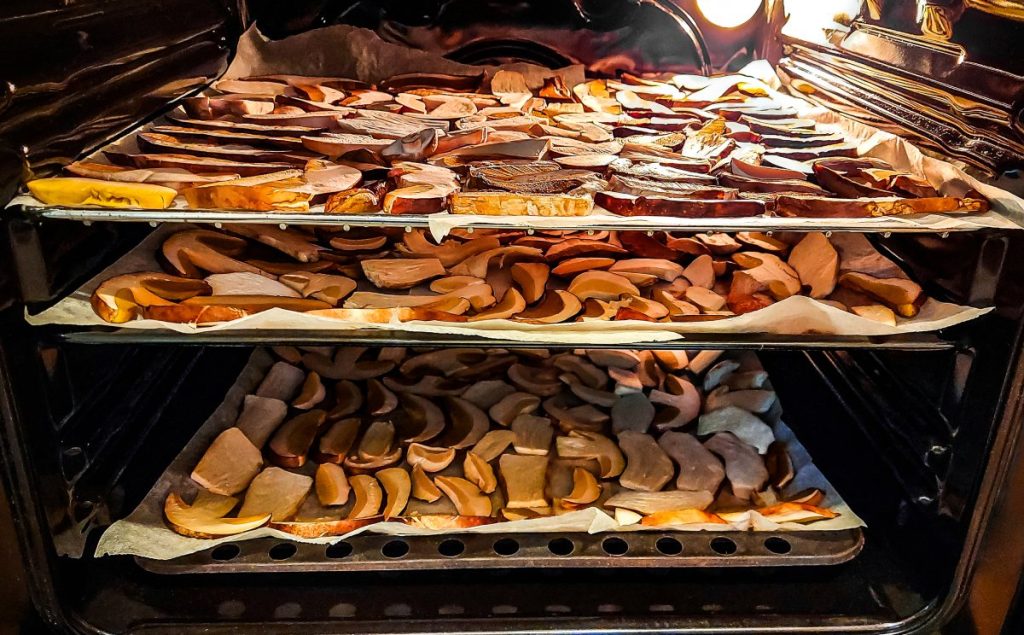
If you don’t have a dehydrator, you can dry mushrooms in your oven using the steps below:
Step 1: Clean and Slice the Mushrooms
The first step is to clean and slice your mushrooms in preparation for drying.
This process is the same regardless of whether you use a dehydrator or an oven to dry mushrooms.
Follow steps 1 and 2 of the dehydrator method above to clean and slice your mushrooms.
Step 2: Preheat the Oven
Preheat your oven to 140°F (60°C).
When drying mushrooms in an oven or dehydrator, use low temperatures of not more than 150°F (60°C) as higher temperatures may destroy the active compounds in mushrooms.
If your oven doesn’t go as low as 150°F (65°C), you can still use it to dry mushrooms.
Set the oven to the lowest possible temperature and keep the door open a little to increase airflow and reduce the temperature.
In this case, it’s a good idea to use an oven thermometer to ensure you get the correct temperature inside the oven.
Step 3. Arrange the Mushrooms on a Baking Sheet
Line a baking sheet with parchment paper and arrange your mushrooms in a single layer with spaces between them.
Make sure that there’s no excess water on the mushrooms and that none of them touch or overlap.

Step 4: Dry the Mushrooms
Place the baking sheet in the preheated oven and leave the mushrooms for one hour.
Then remove them from the oven, blot any visible moisture on the mushrooms, turn them over and return them to the oven for another hour.
At this point, your mushrooms may be dry. But depending on the thickness of your mushrooms, it can take up to 8 hours.
To check if your mushrooms are dry enough, allow them to cool and try to break them. They should be cracker dry and snap easily.
If they’re leathery and bend, turn them over again and return them to the oven for another 30 minutes.
Continue checking and turning them every 30 minutes until they’re brittle.
How to Air Dry Mushrooms Naturally

This drying method requires no equipment and doesn’t use electricity, so it’s the cheapest way to dry mushrooms. But it does take longer than the other methods.
Another benefit of drying mushrooms naturally is that they often retain their flavor better.
But, air-dried mushrooms generally don’t get as dry or last as long as mushrooms dried in a dehydrator or oven.
Follow these easy steps to air dry your mushrooms:
Step 1: Clean the Mushrooms
First, trim off any bruised or damaged sections.
Then rinse the mushrooms under running water and pat them with a kitchen towel to dry them.
Step 2: Prepare the Mushrooms
There are two ways to air dry mushrooms, and which you choose will dictate how you prepare them.
1. In a Container
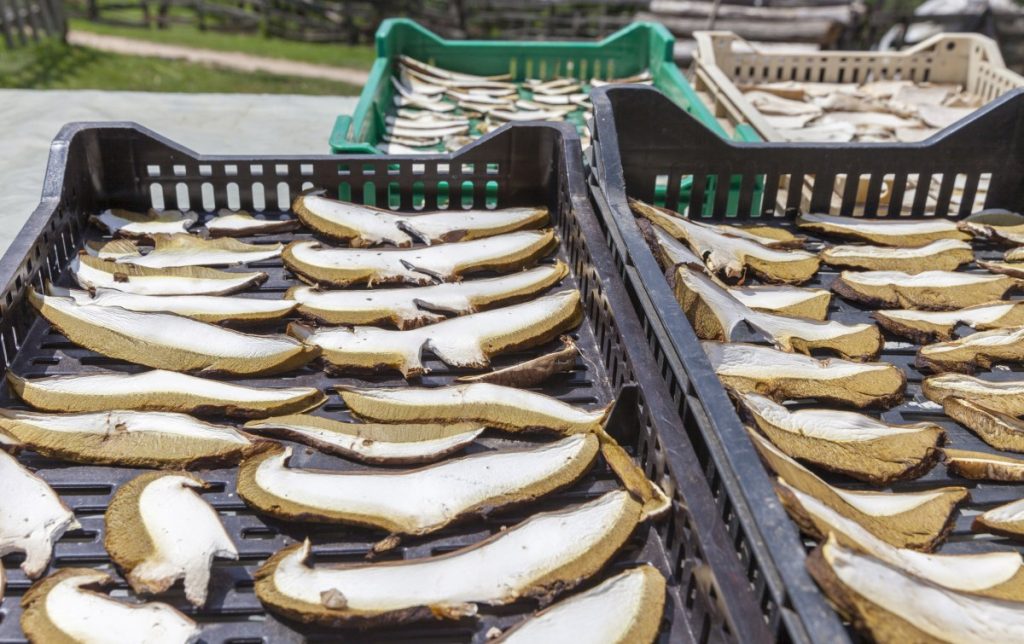
One of the ways to air dry mushrooms is using a container, like a mesh colander, that allows air to circulate all around them.
Alternatively, a baking rack or mesh screen set on top of a baking sheet will also work, as long as there’s sufficient airflow above and below the mushrooms.
You can use this method to dry whole mushrooms, mushroom caps or pieces and sliced mushrooms.
The thinner the slices, the quicker your mushrooms will dry.
To prepare sliced mushrooms for this method, slice them into 0.2 inch (0.5 cm) slices lengthways, so each slice includes a portion of the cap and stem.
Then arrange the mushrooms in the container in a single layer and ensure the pieces are not touching or overlapping.
2. On a String
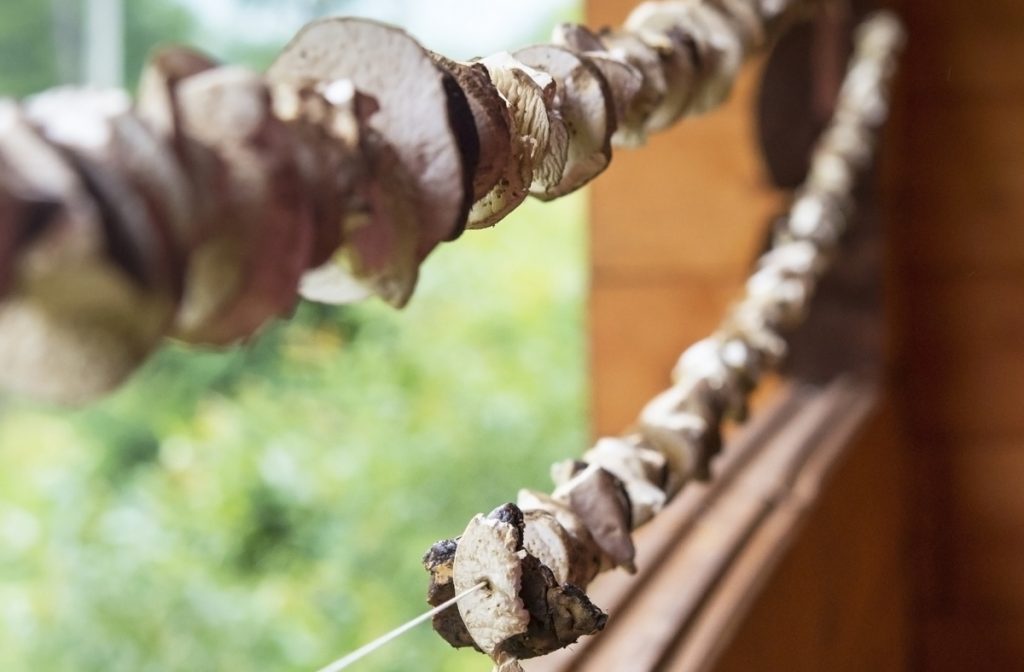
Stringing is a traditional method of air drying mushrooms that people have used for centuries.
It’s perfect for those with limited space because you won’t lose counter or tabletop space while drying your mushrooms.
When using this method, be careful not to slice your mushrooms too small, making it difficult to thread them.
Use a sterilized needle to thread the mushroom pieces onto sturdy thread or cooking string as if you are making a popcorn garland or bead necklace.
An easy way to sterilize the needle is to flame-sterilize it using an alcohol lamp or candle.
Step 3: Air Dry the Mushrooms
Place the container or hang the string in a well-ventilated location where animals, birds, bugs and moisture won’t get to the mushrooms.
Depending on the size of the mushroom pieces and humidity levels, air drying takes 7 to 10 days.
To speed up the process, you can place your mushrooms in direct sunlight or use a fan to increase the airflow.
Sun-dried mushrooms are often ready in under 5 days, and, as an added benefit, exposing the mushrooms to sunlight increases their vitamin D levels.
How to Freeze-dry Mushrooms
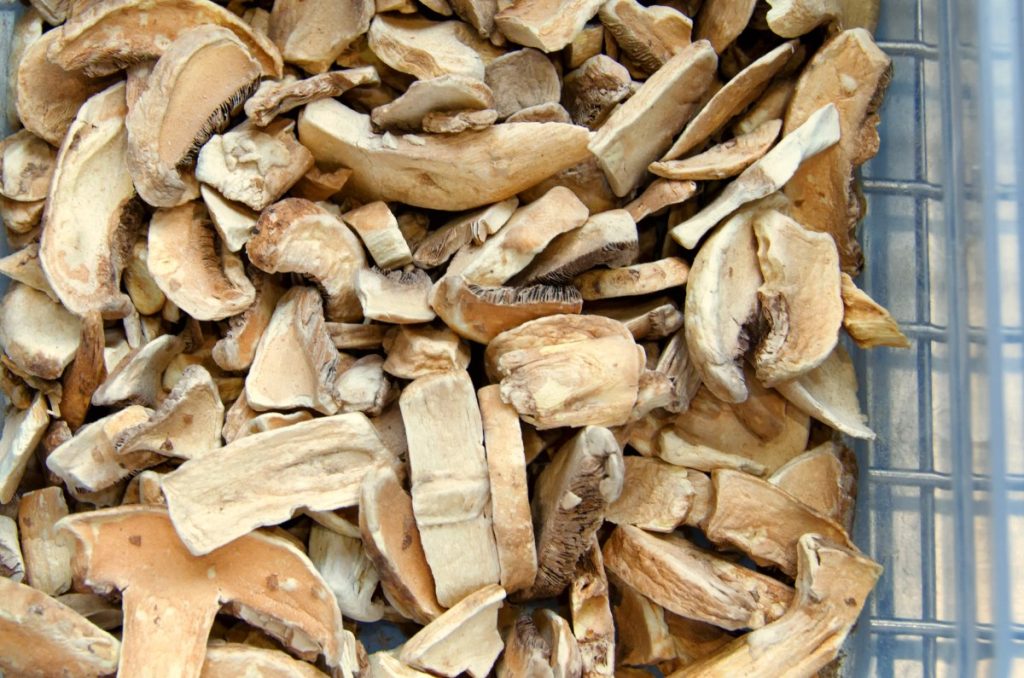
When mushrooms are properly freeze-dried and correctly stored, they can last for up to 20 years.
Because the drying process uses lower temperatures, freeze-dried mushrooms retain most of their flavor, texture and nutrients.
But as freeze dryers are costly, this method may only be worthwhile if you are planning on selling dried mushrooms or you want to freeze-dry other fruits and vegetables as well.
Inside a freeze dryer, the mushrooms go through 2 processes:
- Freezing: Pre-freezing your food before putting it into the freeze dryer speeds up this process
- Drying: When the food has reached the desired temperature, usually between -30 to -50°F(-34 to -45°C), the freeze dryer creates a vacuum that extracts water from the frozen mushrooms.
Follow the steps below to freeze-dry mushrooms:
Step 1: Clean and Slice the Mushrooms
Clean and slice your mushrooms using the instructions in steps 1 and 2 of the dehydrator section above and pat them dry.
While you can freeze-dry whole mushrooms, sliced mushrooms freeze-dry best as you expose a greater surface area to the vacuum.
Even thicker slices freeze-dry well but take a little longer.
Step 2: Pre-Freeze your Mushrooms (Optional)
This step is optional as you can place clean, sliced mushrooms directly into the freeze dryer.
But pre-freezing reduces the time it takes and helps to prevent any contamination during the drying process.
To pre-freeze mushrooms, arrange the mushroom slices on a tray that fits in your freezer, leaving enough space for them to freeze separately.
When frozen, transfer them directly to freeze dryer trays for freeze drying or store them in freezer bags until you are ready to freeze dry them.
If you have a small freezer and lots of mushrooms, it may take a few rounds of the tray before all the mushrooms are pre-frozen.
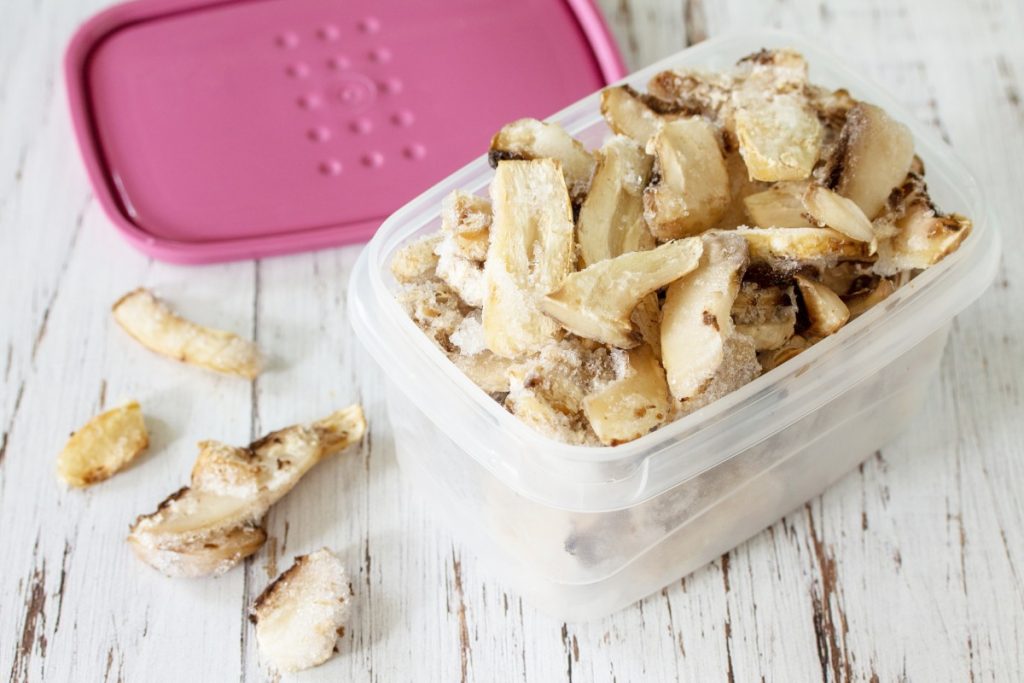
Step 3: Freeze-Dry the Mushrooms
Place your frozen mushrooms on the freeze dryer trays and load them into the freeze dryer.
It takes around a day to fully dry pre-frozen, thinly sliced mushrooms and larger mushrooms or mushrooms that are not pre-frozen may take up to 50 hours.
When the process finishes, check to see if the mushrooms are dry enough.
To do this, break a mushroom. It should be brittle and snap without bending.
There should also be no visible ice in the center of the mushroom slice.
If not done, put the mushrooms back in the freeze dryer for 2 to 3 hours more.
How to Store Dried Mushrooms
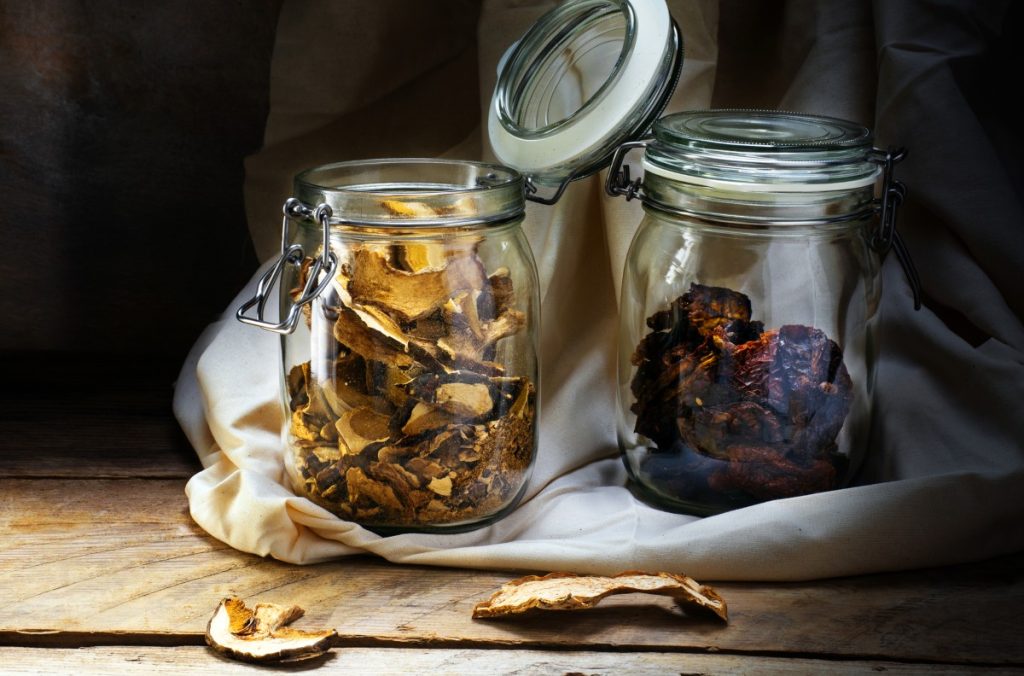
It’s best to store dried mushrooms in airtight containers or bags in a cool, dark, dry place.
But before you put your cracker dry mushrooms away for long-term storage, there’s one last step.
This step is applicable no matter which method you use to dry mushrooms.
It’s a second dryness test, sometimes called conditioning.
To condition dehydrated or oven-dried mushrooms, let them cool completely, put them into a sealed mason jar or ziplock bag and remove as much air as possible.
You can put air or freeze-dried mushrooms directly into the jar or bag as they’re already at room temperature.
Place the sealed container or bag in a cool dark place and check it daily for any condensation forming on the inside.
If you notice condensation and there are no signs of mold, you can put the mushrooms back in the dehydrator or oven to continue drying.
With freeze-dried mushrooms, condensation is a sign they were not completely freeze-dried or accumulated water when removed from the freeze dryer.
You can put them back in the freeze dryer to dry further, but they’ll still have a shorter shelf life.
After a week, if the jars or bags show no signs of condensation, you know your mushrooms are well dried.
You can now package them for long-term storage in well-labeled airtight containers.
If you live in an area with high humidity or plan on opening the container often, we recommend adding a packet of moisture-absorbing desiccant to the container.
Best Types of Mushrooms to Dry
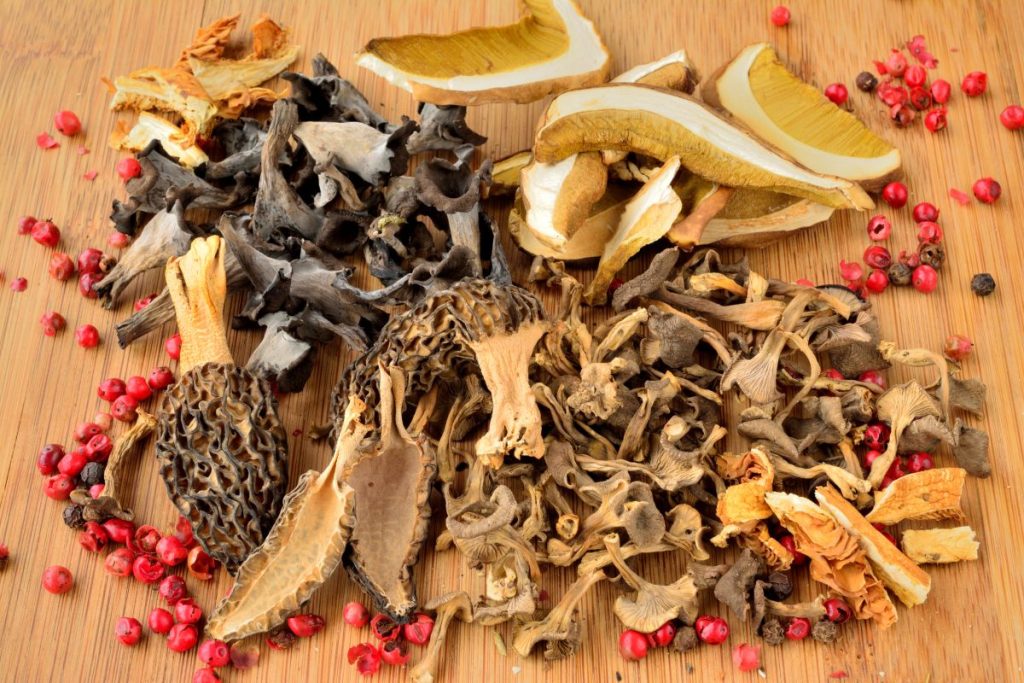
You can dry most types of mushrooms, although some species dry better than others. But regardless of which you choose, always dry fresh mushrooms.
Older mushrooms, showing signs of going bad, won’t last as long and may start to smell when exposed to heat while drying.
To check for freshness, break the mushroom stem off where it meets the cap. The stem should be firm and snap off instead of bending.
This test does not work for shiitakes as their stems are too tough, but you can look for other signs.
If your mushrooms look or feel slimy, bend instead of break and have black or brown spots, they’re not fresh enough for drying.
Larger, meatier mushrooms dry exceptionally well, and some mushrooms have textures and flavors ideally suited to drying.
Some of the most well known and commonly dried gourmet mushrooms are:
Some more unusual types of mushrooms that are also frequently dried include lion’s mane, tremella and hedgehog mushrooms.
And medicinal mushrooms like chaga, reishi and turkey tail are all dried and used for medicinal mushroom powder, tinctures and infusions.
Dried shiitake mushrooms are richer in flavor than fresh shiitakes and one of the most popular dried mushrooms.
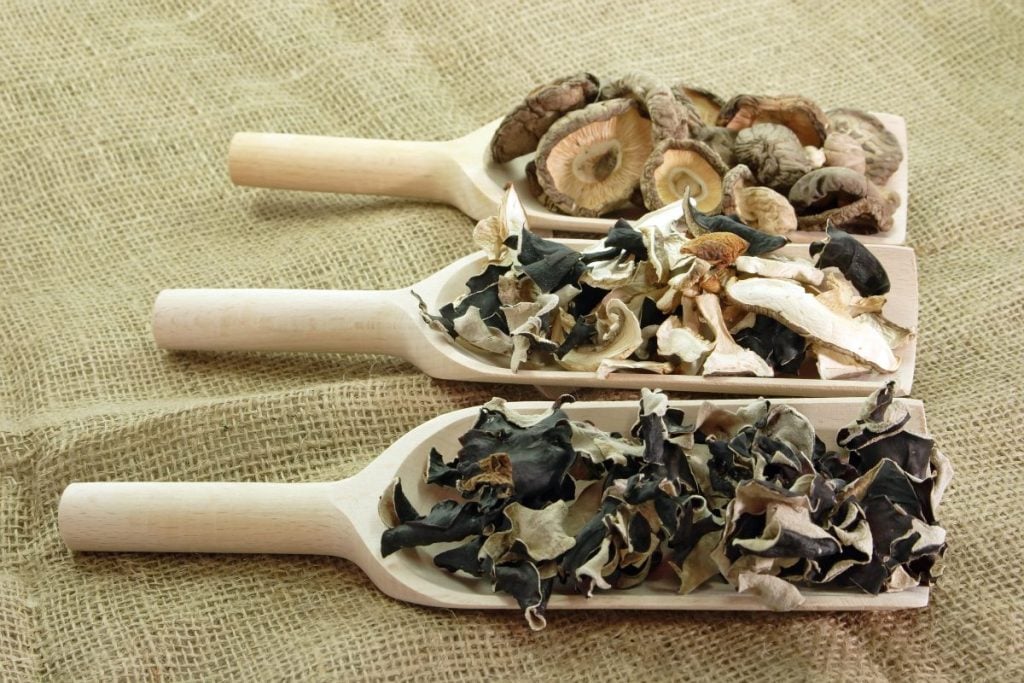
How to Dry Shiitake Mushrooms
You can dry shiitake mushrooms using all the drying methods above, but people commonly air-dry or dehydrate them.
Follow the steps above to dry shiitake mushrooms using the different methods with one exception.
Because shiitakes absorb water very easily, it’s best to avoid water when cleaning them.
To clean shiitakes, first, cut off their stems and any damaged sections and then brush them with a soft bristle brush or wipe them clean with a paper towel.
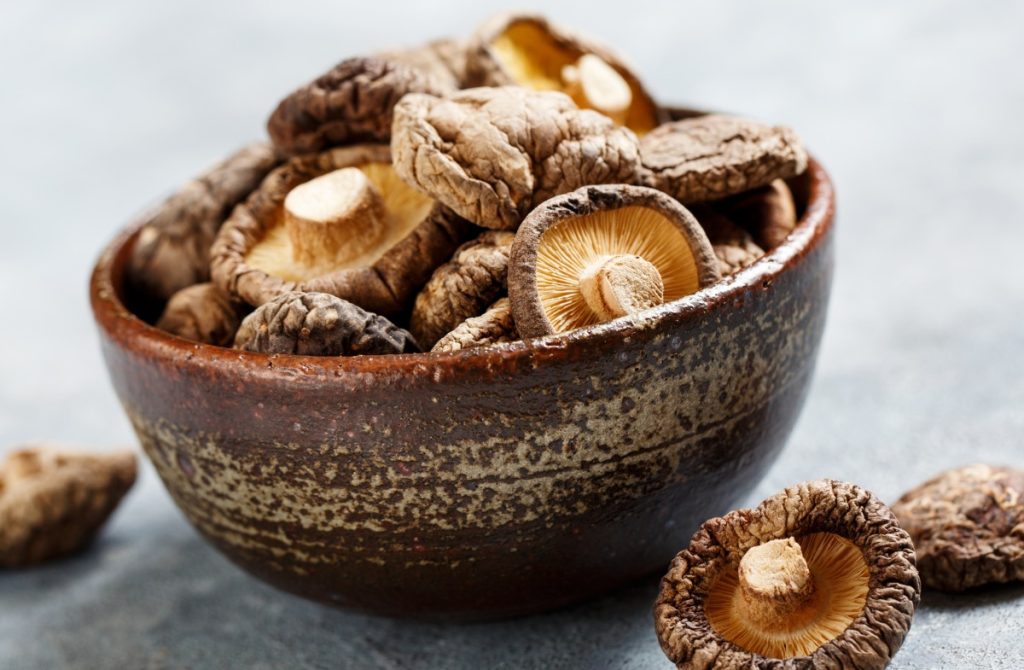
How to Use Dried Mushrooms
Dried mushrooms are convenient to have in your pantry or cupboard as there are so many ways to use them.
To use dried mushrooms, you need to either rehydrate them or use them to make mushroom powder. Both will add rich, savory flavors to your meals.
Rehydrate Dried Mushrooms
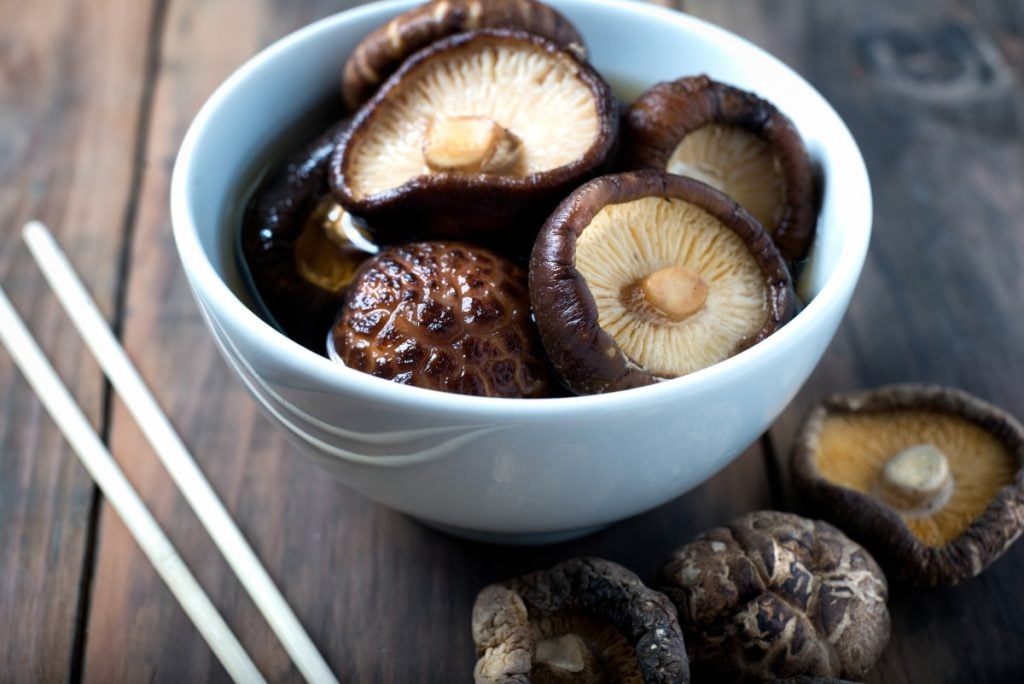
Rehydrate your dried mushrooms by placing them in a heat-proof bowl, covering them with boiling water and letting them soak for 20 to 30 minutes.
It’s best to rehydrate them right before you plan on using them, and as a bonus, you can use the water they soaked in to flavor dishes.
Once rehydrated, you can use the mushrooms in the same way as you would fresh mushrooms, and they’re ideal for:
- Soups
- Broths
- Stews
- Risottos
- Gravy
- Sauces
- Pates
- Gratins
Make Mushroom Powder
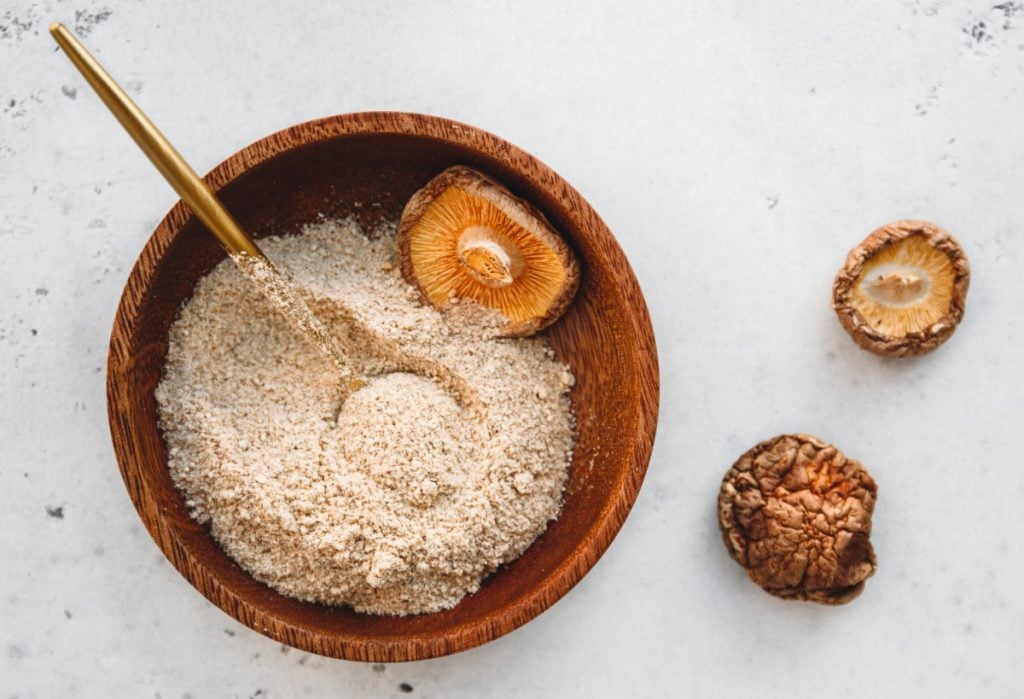
Blend or grind your dried mushrooms into a powder and use it to add mouth-watering umami tastes to savory dishes.
The best part of using mushroom powder for flavor is that you also get the health benefits of mushrooms at the same time.
Use your mushroom powder to:
- Season steak, chicken or ground beef
- Stir into soups, stews, curries and sauces
- Sprinkle over egg dishes and stir-fries
- Toss with vegetables before roasting them
You can also add mushroom powder to tea or coffee and include it in healthy smoothies.
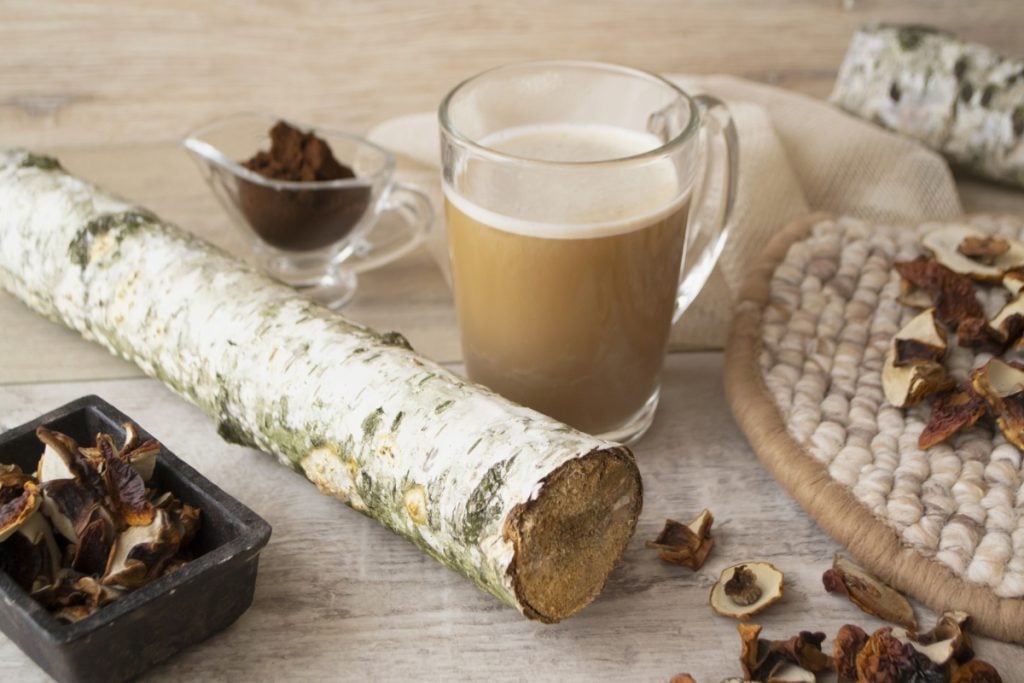
Selling Dried Mushrooms
If you have a small mushroom farm and sell fresh mushrooms to restaurants or at farmer’s markets, dried mushrooms may be a great source of additional income.
But, you’ll need to do some research and check with local, state, and federal regulators to find out the legal requirements for selling packaged products in your area.
There are often more regulations for selling packaged products than for fresh produce.
There will most likely be labeling requirements, and you may need an inspection of your production facilities.
And, keep in mind, tax rates are sometimes higher for income generated from prepared products rather than fresh produce.
But there are several benefits to selling dried mushrooms, including:
- Not having to worry about surplus mushrooms going bad
- Being able to use less than perfect mushrooms to make mushroom powder
- It’s easier to ship dried mushrooms so you can reach a broader market

Final Thoughts
Learning how to dry mushrooms is beneficial for all mushroom lovers, and there are several methods available.
Everyone from mycophiles who love foraging for wild mushrooms to enthusiasts who grow their own mushrooms can preserve surplus fresh mushrooms by drying them.
Dried mushrooms allow you to add the goodness of mushrooms to your meals when you can’t get fresh mushrooms.
But, the best way to ensure an ongoing supply of your favorite fresh mushrooms is to grow them yourself.
To learn more about growing mushrooms, visit our Mushroom Growing Hub or sign up for our introductory course on Growing Mushrooms at Home.
